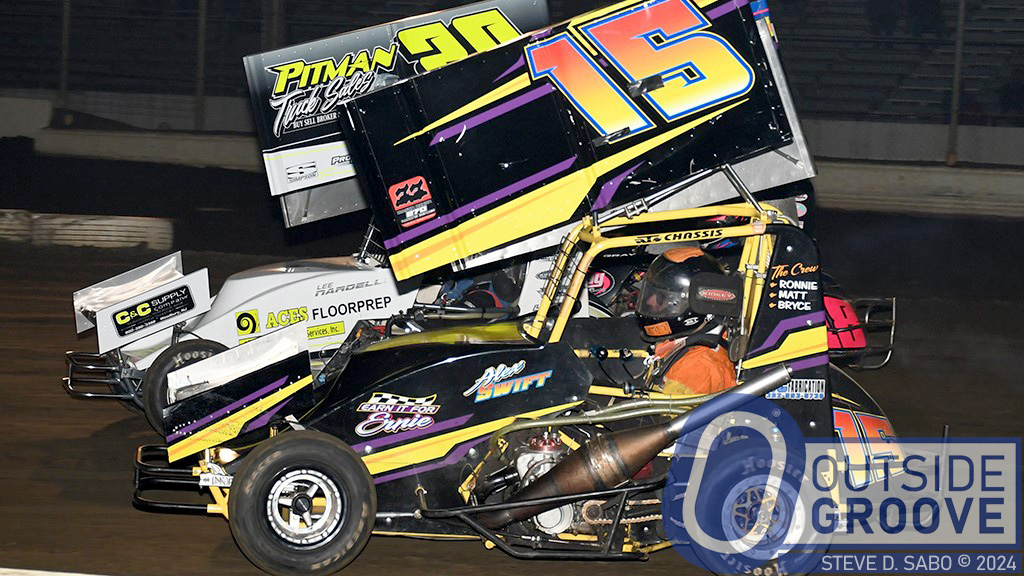Last Friday, Alex Swift won in the 270 sprints, his 42nd at Bridgeport Motorsports Park in New Jersey. Now 37 years old, he started as a kid in the 250s and then moved into the 270s.
“I never got out of the micros — they gave me everything I was looking for,” Swift, of Bridgeport, New Jersey, said. “I tried the 600 class years ago, but I got priced out. The cost is even higher now.”
Surprisingly, winged 270 sprints run only a few tenths slower lap times than 600s at Linda’s Speedway in Jonestown, Pennsylvania, according to Swift. While the 270s did experience a contraction of car count in the past, but Swift said the 270 sprint class is growing nowadays.
“You get more bang for the buck in this division,” said Swift. “You don’t tear up as many tires — that’s why drivers are coming back to 270 racing. The resurgence of this division surprises me. We had 90 cars last year at Linda’s Speedway for the Nationals and 40 cars at the Clyde Martin Memorial Speedway [in Newmantown, Pennsylvania,] race two weeks ago.”
With a smaller wheelbase than most race cars, it makes chassis setup a fine art. The same thing applies for the smaller engine. Swift comes to the track with an AcuRite weather station. He constantly checks his MyChron air/fuel sensor, water temperature and spark plug.
“I check air density — humidity changes make a big difference,” Swift said. “I use the MyChron in conjunction with reading the spark plug. When running an engine on pure methanol, it is easy to run too rich or too lean. I pull the plug every time I come in from the track.
“If your water temperature is 150° F while racing, expect something bad to happen — slow down or pull off. When you suck air, the temperature rises and the spark can become erratic. Because the engine completes two combustions per cycle, the piston can swell in the cylinder. Timing issues can burn a hole in the piston. High temperatures can also indicate air pockets in the water lines and the radiator not working properly to cool things down.”
Running a 270 sprint does not come without its challenges. Swift, like many others, use engines from 1992–2001 Honda dirt bikes. Others use the power plant from a Yamaha bike.
“The age of the engines makes it a bit harder to find parts,” said Swift.
Alex Swift said a racer could find a winning used 270 sprint for less than $6,000. While he admitted that he wouldn’t turn down racing a big-block modified, he doesn’t see himself leaving the 270s due to his available budget. However, Swift’s not heartbroken over it. He enjoys racing for the 270 sprint team owned by John and Amanda Blanda, which he has won 52 features with since 2018.
“I’m a career two-cycle guy,” Swift said. “I like the idea that you can make or break your night of racing with one little thing done wrong. In this division, you have to know yourself, know your car and the more you learn the better you will be. When you are on the track and everything is working — the chassis setup is right and the engine is perfectly tuned — there is a sense of accomplishment that would be hard to find racing in any other car.”
Outside Groove Note of Transparency: Clarified the number of wins mentioned and Alex Swift’s desire to race other classes (2024-05-09).
Mike Adaskaveg has written hundreds of stories since the website’s inception. This year marks his 54th year of covering auto racing. Adaskaveg got his start working for track photographer Lloyd Burnham at Connecticut’s Stafford Motor Speedway in 1970. Since then, he’s been a columnist, writer, and photographer, in racing and in mainstream media, for several outlets, including the Journal Inquirer, Boston Herald, Stock Car Racing, and Speedway Illustrated. Among Adaskaveg’s many awards are the 1992 Eastern Motorsport Press Association (EMPA) Ace Lane Photographer of the Year and the 2019 National Motorsports Press Association (NMPA) George Cunningham Writer of the Year.





